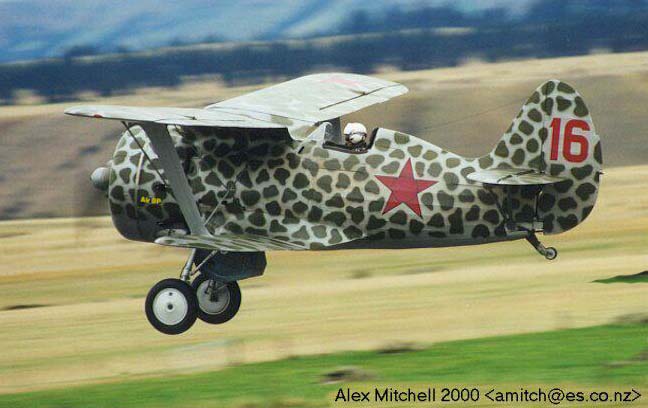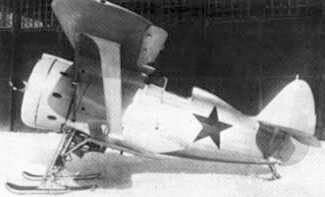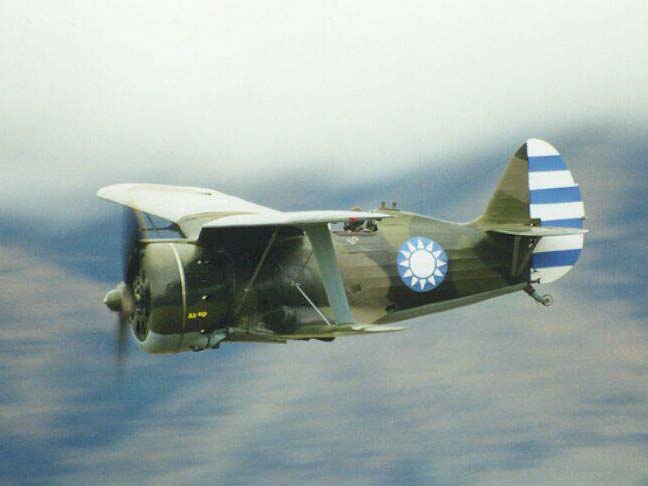WARBIRD RESOURCE GROUP > RUSSIAN AVIATION > FIGHTERS > PREVIOUS PAGE

|
Type: Single seat fighter Origin: Polikarpov Model: I-153 Crew: One First Flight: 1938 Service Delivery: 1939 Final Delivery: 1941 Number Produced: 3,437 Powerplant: Model: Shvetsov M-62 Type: 9-cylinder, air cooled radial Number: One Horsepower: 1,000 Dimensions: Length: 6.18 m (20 ft 3 in) Wingspan: 10m (32 ft 9¾ in) Height: 2.80m (9 ft 2¼ in) Wing area: 22.14m² (238.32 ft²) |
Weights: Empty weight: 1452 kg (3,201 lb) Loaded weight: 1,765 kg (3,883 lb) Max takeoff weight: 1,859 kg (4,090 lb) Performance: Maximum speed: 444 kph (276 mph) Range: 470km (292 miles) Service ceiling: 11,000 m (36,080 ft) Rate of climb: 15 m/s (2,985 ft/min) Wing loading: 80 kg/m² (16 lb/ft²) Power/mass: 0.34 kW/kg (0.21 hp/lb) Armament: Four 7.62 mm ShKAS machine guns Ammunition: 2,500 rounds of ammunition total |
The Polikarpov I-15 was an unpopular design with VVS. The distinctive "gullwing" top wing offered poor longitudinal stability and visibility, the aircraft suffered from poor build quality, and top speed was considerably worse than that of the monoplane Polikarpov I-16. As the result, I-15 was withdrawn from production in 1935. In 1936, a batch of I-15 was sent to aid the republicans in the Spanish Civil War. The aircraft performed well enough to make VVS reconsider their view of biplane fighters and Polikarpov was ordered to create an improved version based on combat experience. While the wholly unremarkable I-15bis was entering production, the OKB was already working on a more advanced version with the new ShKAS machine guns, Shvetsov M-62 engine, and retractable landing gear (It is interesting to note that this was one of the first projects that Artem Mikoyan of future MiG fame actively took part in). The proposal for the new figher called I-153 (literally, I-15, 3rd version) was submitted in 1937. The first prototype powered by the Shvetsov M-25 engine was completed in August 1938. It failed factory testing due to numerous defects which were largely corrected in the second prototype and the aircraft entered production concurrently with ongoing testing and development. In test flights, the I-153 (M-25) achieved the top speed of 424 km/h (265 mph), service ceiling of 8,700 m (28,500 ft), and required 6.4 minutes to reach 5,000 m (16,400 ft). This was disappointing performance but Polikarpov had high hopes for the new Shvetsov M-62 engine. The first I-153 (M-62) was delivered on June 16, 1939. Top speed improved to 442 km/h (275 mph) with service ceiling of 9,800 m (32,150 ft). This was still short of the projected top speed of 462 km/h (287 mph). In addition, one of the production aircraft disintegrated in a 500 km/h (310 mph) dive revealing a significant structural weakness. Combined with other defects revealed in testing and persistent poor visibility caused by the top gullwing, the aircraft failed the government acceptance trials. While numerous improvements were proposed, many were too radical to be implemented since the aircraft was already in production. Desperate to improve performance, Polikarpov tested two I-153 with the Shvetsov M-63 engine with 1,100 hp (820 kW). However, the results were disappointing and it was becoming painfully obvious that the biplane airframe was incapable of higher speeds.
One of the rarely mentioned characteristics of the I-153 was its poor performance in a spin. While the Polikarpov I-16 had gained notoriety for entering spins, it was an easy aircraft to recover. In contrast, while I-153 was difficult to spin, once it lost control recovery was difficult to the point where intentional spinning was forbidden for some time. A spin recovery procedure was eventually developed but, while effective, it required flawless timing and execution.
By the end of production in 1941, a total of 3,437 I-153 were built.

I-153 first saw combat in 1939 during the Soviet-Japanese Battle of Halhin Gol in Mongolia. The Japanese Type 97 Fighter (Nakajima Ki-27) proved a formidable opponent for I-15bis and I-16 but was more evenly matched with I-153 which retained agility inherent to biplanes while featuring improved performance. While the overall I-153 performance was satisfactory, some significant problems were revealed. Most troublesome was the absence of a firewall between the fuel tank mounted in front of the cockpit and the pilot. Combined with strong draft coming in through the wheel wells, fuel tank fires invariably resulted in rapid engulfment of the cockpit and severe burns to the pilot. In addition, the M-62 engine suffered from a service life of only 60-80 hours due to failures of the two-stage supercharger.
Stalin's purges in the 1930s resulted in a tremendous lag in Soviet aircraft at the beginning of World War II[citation needed]. Although the new Yak-1 and LaGG-3 fighters were entering production, on June 22, 1941 the bulk of VVS was equipped with the obsolete 1930s designs including a large number of I-153. Even as late as 1942, there were attempts to reinstate production of I-153 and I-16 to fill the shortage of fighter aircraft.

While attempts to improve performance proved largely fruitless, Polikarpov had some success in upgrading the armament. I-153 underwent trials with two synchronized 12.7 mm TKB-150 (later designated Berezin BS) machine guns, and about 150 aircraft were built with a single TKB-150 in the fuselage and two ShKAS in the wings (a single TKB-150 was used because of the shortage of this weapon which was shared with I-16 Type 29). Late in production, about 400 aircraft were modified with metal plates under the wings to accommodate RS-82 unguided rockets. Other modifications included:
I-153BS - Fitted with four 12.7mm BS machine guns instead of ShKAS machine guns.
I-153DM - On an experimental basis, the I-153DM was flown with gasoline-burning ramjet engines under the wings. DM-2 engines increased the top speed by 30 km/h (19 mph) while more powerful DM-4 engines added as much as 50 km/h (30 mph). A total of 74 flights were performed.
I-153GK or (I-153V) - high-altitude version with a pressurized cockpit, did not enter production
I-153P - two synchronized 20 mm ShVAK cannons, added firepower was offset by the increase in weight and tendency of gunpowder to foul the windscreen
I-153Sh and USh - ground attack versions with underwing containers with ShKAS machine guns and 2.5 kg (5.5 lb) bombs
I-153TKGK - high-altitude version with a turbocharged engine and a pressurized cockpit, top speed of 482 km/h (300 mph) at 10,300 m (33,785 ft), 26 built for air defence
I-153UD - rear fuselage completed as a wooden monocoque rather than fabric-covered steel and wooden frame to save metal, did not enter production
Fifty I-153 were equipped with larger oil tanks and plumbed to accept external fuel tanks under the wings which doubled the combat range. These were largely used by the Soviet Navy.
I-190 - experimental version powered by a 1,100-hp (820-kW) M-88V radial piston engine.
WARBIRD RESOURCE GROUP > RUSSIAN AVIATION > FIGHTERS > PREVIOUS PAGE
